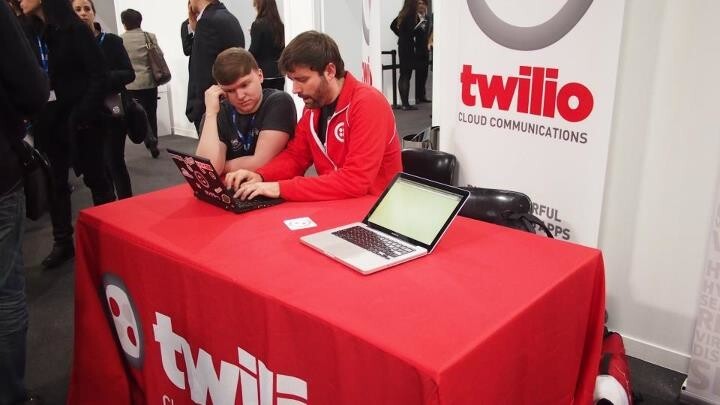
In the past two years, the explosion in web technologies and apps has created a new profession: It’s called Developer Evangelism, and it’s seriously awesome.
“It is an incredible job – although you still have to explain to a lot of people what you do,” says Christian Heilmann, the Principal Technical Evangelist at Mozilla who literally wrote the book on the profession called Developer Evangelism, announcing it as a “new role in IT companies” in 2009.
The role doesn’t involve coding all day long (although there’s plenty of that involved). It’s not marketing, PR or sales, although there are plenty of shared adventures to be had. It’s not recruiting, but that happens too. One thing is for sure, it doesn’t involve a lot of sleep. So what is it? We asked Heilmann to define it:
A developer evangelist is first and foremost a translator. Someone who can explain technology to different audiences to get their support for a certain product or technology. It needs to be someone who is technical but also capable to find the story in a technical message… A good developer evangelist can get techies excited about a product by pointing out the benefits for developers who use the product on an eye-to-eye level.
Much like how the boom in social media birthed new positions that were two parts marketing, one part customer service, developer evangelism is a unique blend of business, product development, customer care and everything in between. They’re spokespersons, mediators, and translators between a company and both its technical staff and outside developers. Although the role is nothing new (Guy Kawasaki was one of the first at Apple), there definitely is an uptick (and competition) for hiring for this position now — so what do modern day “developer evangelists” look like?
Twilio’s Rob Spectre
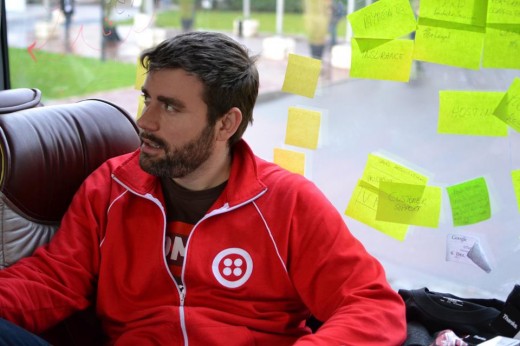
“I’m pretty much a professional skateboarder. Twilio gives me sneakers, clothes and sends me around the world to do my thing. It’s just not as cool.”
In the month of March, Rob Spectre, Twilio‘s Developer Evangelist was home in New York City for a total of 7 days. First he was at SXSW, where Spectre joined the Twilio team to promote the brand in Austin, Texas. “It was super guerilla. We coated 2 SUVs in temporary Twilio decals and cruised around launching t-shirts out the windows… Unlike hackathons, which are dev centric, conferences like SXSW and LeWeb are purely about brand play for us. We go to see and be seen… It was non-stop hustling from 9-2am.”
With a slew of hackathons and meetups in between like Boston’s Startup Weekend and Philly’s PennApps, he also spent a week in Barcelona for Mobile World Congress. “I was pretty much in a coma after that…I need to find a way to make this sustainable. People are starting to tell me I look tired,” he says laughing. “But really, I’ve had 2 weekends off since the beginning of the year and one was our company ski trip.”
What does your day look like? “I usually get up around 8 and take a run across the Williamsburg Bridge. Then I get coffee and answer email on the way back from the coffee shop on my phone. Today, I cut a little code in the morning. At noon, we have a team lunch. At 2, I’m meeting with a company to talk about our API. It’s all coffee meetings after that and living off my calendar.”
Before joining Twilio in August 2011, Spectre was a full-timer at Boxee, a company that lets you cruise the Internet and a slew of fun apps right on your TV. “Coming from an engineering background, Twilio is my first ‘soft job’, that is, a non technical job,” he says.
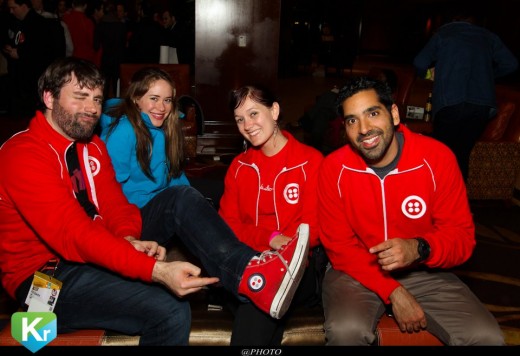
When Spectre visited PennApps in January of this year, it was at the height of the SOPA/PIPA debates. He helped 3 students on the Grassroutes team build a deceptively simple widget using Twilio’s API that lets visitors call all of their Congressional representatives right from their computers with one click. “These kids get no support from administration or faculty. The school only gave them a hallway to run this thing,” says Spectre.
A number of well-known companies have tapped into Twilio’s API including GroupMe, Hulu (for customer service) and ZenDesk (for customer service). While Spectre has seen a few fun developments using the API such as a hacked microwave that uses Twilio SMS to text you when your food is done, this year, Twilio is getting serious for election season as nearly every single campaign is using its API from Obama to Ron Paul. “They’re like circuses,” says Spectre. “You have a finite amount of time to make your impact. You have to look bigger than you are and it has to be huge and sensational, but then when it’s over, everyone packs up and it disappears.”
For the campaign trail, Twilio delivers an insane amount of fluidity in comparison to antiquated options such as renting a call center, connecting outbound lines and buying loads of hardware. Instead of paying these monthly overhead fees, using Twilio cost just $1 per month.
This past February, Twilio released its voice client iOS SDK, which enables developers to create call centers, mobile Skype alternatives, voice-enhanced mobile games, dating apps and social dialers, one of which replaces the keypad with faces of your friends along with other cool features. “If group messaging was all the rage last year… social dialing will be a big part of this year,” says Spectre.
Spectre is one of Twilio’s eight developer evangelists: There are three in NYC, one in Austin, TX, one in Seattle, one in Charlotte, one in San Francisco and then there’s Stevie Graham, who holds down Twilio’s international footing in London.
Foursquare’s Akshay Patil
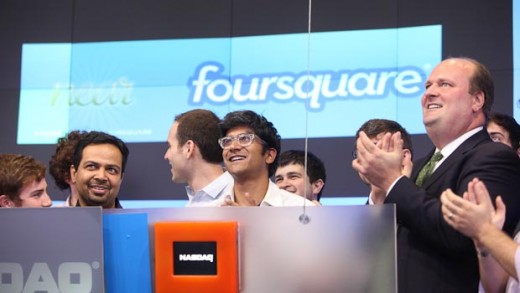
“We see such creativity and are inspired by our developer community so we’re not overly territorial. Our attitude to our developers is that ‘they can build what they want to build’. Meanwhile we remain confident we’re building the right experience for our user base.”
Foursquare‘s developer community just reached 20,000, measured by the number of people who create a consumer key to hit its API. “As our community expands we are going to need people to mature our API offerings. Right now, we’ve given our community attention and love but we’re going to have to be smarter in the ways we communicate, explain our tools and help them,” says Akshay Patil, Foursquare’s Platform Evangelist.
Unlike most developer evangelists, Patil doesn’t travel as much as he could. With requests coming in from all over the world, Patil stays focused at home base in New York City. This year, he will build his developer community team with an additional 5 people, making frequent travel more likely.
Previous to Foursquare, Patil was a Google Engineer for 6 years and met Foursquare execs Dennis Crowley, Alex Rainert and Harry Heymann while they were working on Dodgeball. He’s also the creator of Partychat, which lets you create chat rooms with your friends or co-workers using Google Talk or XMPP.
Does he have the Foursquare API memorized? “Yes, at this point, pretty much. I even have dreams in which I’m doing my job and launching cool features,” says Pital.

Foursquare’s API community grows with its user community and is particularly strong in San Francisco and NYC, which may come as no surprise. Patil also says the API gets a lot of love from places like Montreal, Paris, London and Tokyo. We asked him to list his favorite uses of the Foursquare API. Check them out below!
Best uses of Foursquare’s API:
- Timehop: The ultimate daily nostalgia kick that reminds you of your Foursquare checkins, Instagrams, tweets, Twitter photos and Facebook posts from a year ago, each day.
- Dont Eat At: Sends a text message when you check into a restaurant that is at risk of being closed for health code violations.
- Plan Your Next Trip: The app uses Foursquare’s Explorer API to generate a personalized two-day vacations for travelers. (As the winner of Foursquare’s Global Hackathon, Plan Your Next Trip’s creator, Benjamin Netter was flown to NYC from Paris to have dinner with Foursquare co-founder Naveen Selvadurai. That’s one pimpin’ API!)
- AMEE Location Footprinter: Tracks your carbon footprint based on your Foursquare check-ins.
- TripsQ: Uses your Foursquare history to map the travel you’ve been doing and shows you how far you’ve flown, what legs you’ve done, and your Co2 footprint based on flights.
- 4sqwifi: Enables you to find nearby venues which offer WiFi — and their password.
- Peer in Paris: This app lists all of the public toilets in Paris, depending on your location. It also lets you check-in if you’d like to.
- The BlindSpot cane: This cane for blind people doubles as a smartphone and uses GPS and bluetooth technology, including location based services like Foursquare check-ins to help visually impaired people operate with more normalcy.
- Foursquare-powered Social Cooler: It’s pretty straight forward: check-in to the Social Cooler on Foursquare, and watch it magically pop open.
Craziest use of the Foursquare API: “This guy built something you could pee on and it could check you in. He used an Arduino board with a moisture detector and our API to check you into a venue… People love social media and excrement! They’ll always find a new way to combine the two,” says Patil.
Dwolla’s Michael Schonfeld
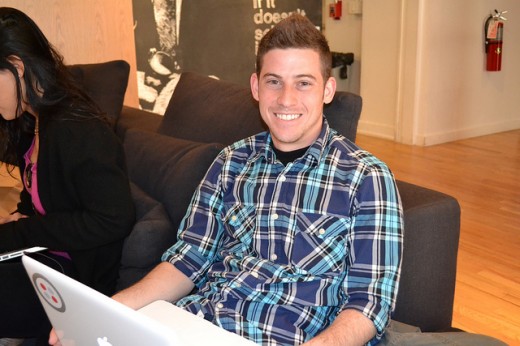
“I get to come in and do whatever I want and whatever I do people are still happy with it.”
In mid-April, the Iowa-based startup Dwolla poached two of New York City’s most talented players including Aviary’s former Biz Dev Alex Taub and Nerve Dating’s Michael Schonfeld. While the two work remotely in New York City’s General Assembly campus, the 20-person team gets together every day on Google Hangout to tell each other what they’re working on.
As Dwolla‘s new Developer Evangelist, I asked Schonfeld how he explains his job to his mom. “Most people hear evangelist and think it’s something religious. So, I tell my mom that I get other developer to use our API tools, which still means nothing to her.”
Schonfeld is originally from Israel and moved to Los Angeles, California to attend Cal State. After he graduated he knew he wanted to dive into a startup scene. “Los Angeles isn’t the biggest startup scene so it was either New York City or San Francisco. And this just seems cooler,” he says.
Whats in your job description? “I don’t have one. At least, not that I’m aware of. What I do is get as many people using our API and getting those API calls maximized in whatever way possible. I do whatever I need to do to make that happen, which means going to hackathons and events all the time, even really obscure events like Kansas City Hackathons.” Last month, Schonfeld attended hackathons in Kansas City, Iowa and Los Angeles.
Most productive hours of operation? “10pm to 3am, basically ’til I just pass the eff out and can’t work anymore.”
Do you ever dream about Dwolla’s API? “Yes, this is horrible. When I start working somewhere, I start dreaming about the syntax and lingo.”
“I heard about Dwolla first from HackerNews and that the whole big thing was that they were really cheap for transactions. I met Alex Taub during oHours in San Francisco and we stayed friends through Twitter. He told me Dwolla was looking for a developer evangelist and a business development head, so we decided to join together,” explains Schonfeld. “Now, we go out together and meet new companies. Alex pimps me out and says, ‘If you guys want this, Michael will integrate this for you in a matter of days’…and then I do.”
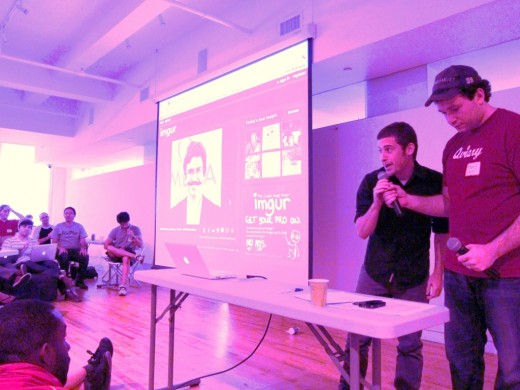
The coolest API user Schonfeld has recruited thus far is Justin Kan, the founder of Justin.TV, who wanted an inexpensive, reliable and easy way of paying out his Execs (personal helpers). Justin started a new venture out in SF called GetExec that allows people to find Execs in real time (à la TaskRabbit). “He was great to work with, because he’s both the Founder, and the Programmer. It’s very rare to have a company dive right into integration during our first meeting/phone call – and that’s exactly what happened with Justin,” says Schonfeld.
Schonfeld is currently working on an integration with reddit, “the front page of the Internet” that will allow users to fundraise for causes they find in subreddits, as well as integrations with NYC-based art startup, Artsicle and Cindy Gallop‘s stealth project Make Love Not Porn.
Most recently, Schonfeld, who tweets by the name @BaconSeason, put out an impresive product with a boring name: The Payment Fees Calculator, which compares the fees you’d pay when moving money around, using one of the leading payment gateways in comparison to Dwolla.
SoundCloud’s Paul Osman

“As a developer evangelist, I think it’s important that you stay a developer. It’d be hard to put myself into a developer’s shoes otherwise. By building apps with our platform, I can get that 3rd party perspective and point things out that I might not have noticed otherwise.”
Paul Osman, the Developer Evangelist at SoundCloud, left Mozilla this past February, because he wanted to work more closely with developers again and people in the developer community. When asked how he defines a Developer Evangelist he said: “Somebody who represents developer’s interests inside of the company.”
Unlike Twilio’s Spectre, travel for Osman has been fairly light including one trip to San Francisco for Music Hack Day and a week of bonding in the SoundCloud office. His day-to-day schedule includes monitoring the support channels and making sure people who post questions to the company mailing list or over the web are helped out. “Basically, anyone struggling with the SoundCloud API, I try to help out. I also spend quite a lot of time writing sample code and trying to figure out where there are holes in our documentation,” he says.
Osman also reaches out to developers who use SoundCloud’s API in particularly neat ways or ways they’d like to showcase. One such app, written at Music Hack Day was whsprs.co, which lets you play a game of telephone using SoundCloud. The app, built by Ian Butterworth lets users connect with their SoundCloud account, and using the Javascript SDK they can record a ‘whisper’. Other users can look for a whisper recorded by someone nearby and repeat it, and so on and so on.
Looking forward, Osman says he’d like to see more visibility into what people are doing with the SoundCloud API. (The company currently has an app gallery that shows a few things going on.) “I think people who use SoundCloud in interesting ways aren’t getting the attention they deserve,” he says.
Osman is working on a number projects at SoundCloud Developers including more frequent blog posts, developer contests, more curation and more aggressive improvement of their API documentation.
Twitter’s Jason Costa
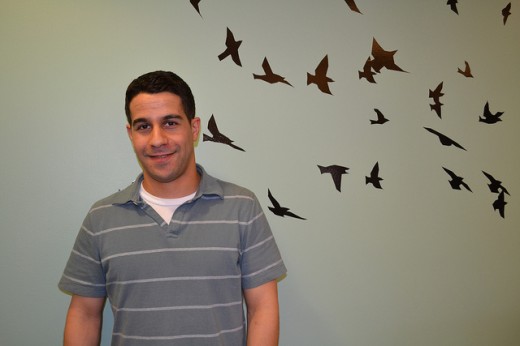
“Twitter feeds us breakfast, lunch and dinner. Thank god it’s catered. Now, if we can just get our laundry done here…”
In March, Twitter announced it had 140 million active users sending 340 million tweets per day. The San Francisco-based startup’s value has been estimated at $4 -$10 billion with revenues of $100 – $110 million per year, and grandmas the world over are still confused as to exactly what the micro-blogging platform is, and why everyone in the world can’t stop tweeting.
As Twitter’s Head of Platform, Jason Costa gets to wear many different hats and work in diverse areas. The three main things he does on day-to-day basis are first, addressing pent up market demand in the ecosystem, and second, matchmaking between the multitude of global brands and large companies that want to get a lot more value of out Twitter. Costa tells me a few of the more notable companies using Twitter’s API include SocialFlow, Crowdbooster, Simply Measured, Lanyrd and CrowdTwist.
His third job and primary focus is growing the ecosystem and spurring adoption of the platform, which recently hit 1.5 million registered apps. Has he memorized Twitter’s API? You bet he has. Does he dream about it? “I definitely have,” he says. “I’m always working with our API, looking for certain issues and trouble shooting both for internal consumption and for our developer community.”
Costa comes from a very impressive background starting with a degree from USC in Engineering as well as a graduate degree from MIT’s Sloan. He joined Twitter in 2008 after working at Facebook as a Product Manager on its mobile team and at Google as a Technical Program Manager.
Twitter’s developer community is hot the world over, especially in Tokyo, Seoul, New York City, London and Berlin. While Costa tries to be conservative with travel, it’s not uncommon for him to visit 9 cities and 3 different continents to meet with thousands of devs in the course of a few months. “I love meeting with developers, but it needs to be done in a scalable way,” he says.
Currently, when people host Twitter meetups in cities such as Malaysia, Seoul, London, New York, Amsterdam and Dublin, Twitter supports them by appointing a local community ambassador to take care of the logistics and then Skype-ing in for a Q&A. For example, Twitter Developer Tea Times are popular in Malaysia and Singapore.
Instead of traditional hackathons, Twitter hosts 72-hour “information dissemination exercises” that draw developers and partners from all over to meet the Twitter team and be able to ask questions. The next similar event will be held in June when Twitter hosts its Platform Services Open House in New York City.
Sagely Advice from Mozilla’s Christian Heilmann

After interviewing the 5 developer evangelists above, we asked Heilmann (Principal Technical Evangelist at Mozilla and author of the handbook: Developer Evangelism) for a few bits of sagely advice that he was kind enough to share with us below.
On Travel: “It is very important to be visible. This could be in-person, around the globe but it is also as important to be online with answers in the right discussion threads, screencasts, videos and the like,” says Heilmann.
“Traveling can be really hard – my schedule was and still is nuts which is why I want [Mozilla’s] Evangelism Reps program to kick off so people can speak in my stead. This is not easy as once you made a name of yourself as being a good speaker with great talks conference organisers will always want you specifically. It is very important to say no from time to time and give good reasons. Don’t leave people hanging wondering if you’d do it or not.
Heimann recommends choosing events that will record or stream talks that way you’ll be able to reuse them in the future.
On Becoming a Developer Evangelist: “If you haven’t worked in delivery of products and felt the pain of developers out there, don’t try to become an evangelist. You need to come from the trenches or you’ll be ripped to shreds by a very knowledgable and cynical audience,” he says. “Also be aware that your integrity is your main weapon. You need to be known as someone who cares and knows about technology, not as a spokesperson for a certain product.”
On Working with your Company: “Information you give out needs to be backed up by the people who deliver the products you talk about or it can get very embarassing very quickly,” he warns. “You are not a performing monkey for engineers in your company, you are their channel out to the world and translate what they do to different audiences.”
The Future of Developer Evangelism: “I can see evangelism… to become a more known part of companies and merge with or take over a lot of the traditional marketing and PR roles. More and more companies realise that developers are just another audience you need to care for as much as you do for end users. I am lucky to work with product people and PR people who get what I want to achieve and work with me instead of seeing me as a threat. I hope that more companies understand that.”
Get the TNW newsletter
Get the most important tech news in your inbox each week.





